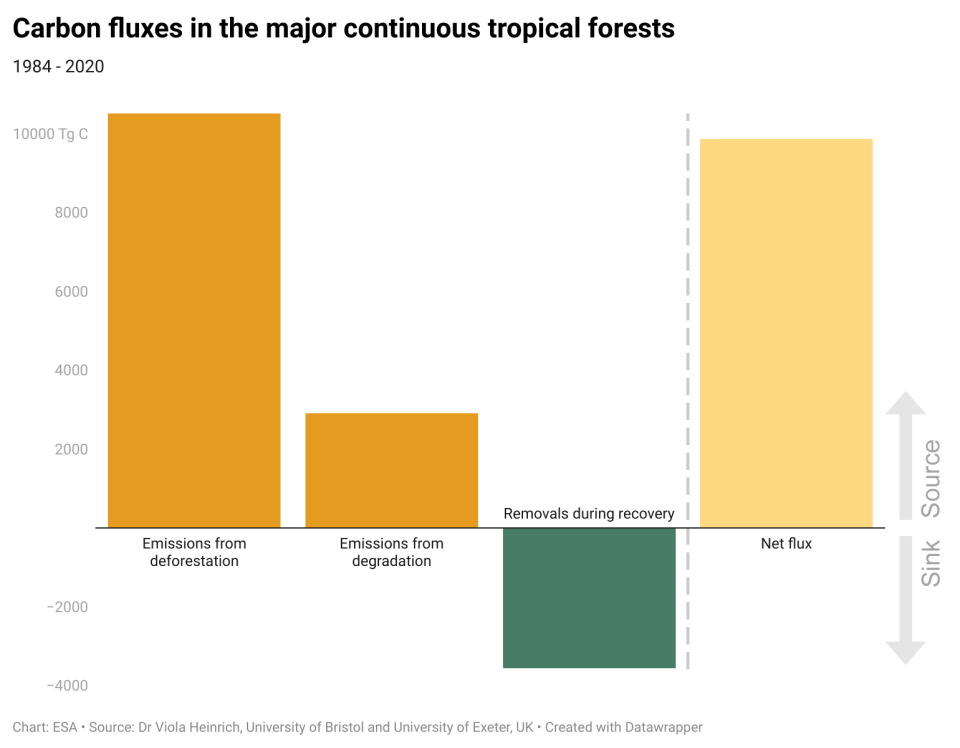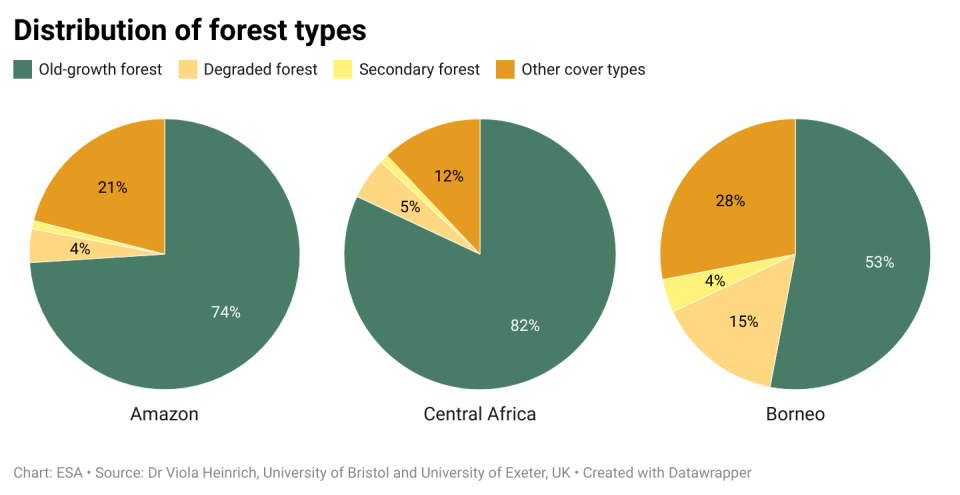Published on 16 March 2023
Forests play a crucial role in Earth’s carbon cycle as they absorb and store large amounts of carbon from the atmosphere. However, climate change, forest degradation and deforestation are causing much of this stored carbon to be released back into the atmosphere, particularly in tropical humid regions.
The new research, published today in Nature and led by the University of Bristol and Brazil’s National Institute for Space Research (INPE), showed how degraded forests and regrowth of secondary forests in previously deforested areas, are annually removing at least 107 million tonnes of carbon from the atmosphere across the Tropics.
This sink is approximately equivalent to counterbalancing half of annual fossil fuel emissions from South America.

Carbon fluxes in the major continuous tropical forests
Using satellite data, a team of international researchers quantified the rates of carbon recovery in different forest types and environments across the three largest tropical forests: Amazon, Central Africa and Borneo.
The findings demonstrate the important carbon value of conserving recovering forests. However, the total amount of carbon being taken up was only enough to counterbalance 26% of the current carbon emissions initially released as a result of humid tropical forest destruction and degradation.
Lead author, Viola Heinrich from the University of Bristol and Exeter, commented, “Our study provides the first pan-tropical, regional-scale estimates of carbon absorption in tropical forests recovering from degradation and deforestation. While protecting ancient tropical forests remains the priority, we demonstrate the value in sustainably managing forest areas that can recover from degradation and deforestation related to human activities.”
The team used satellite datasets that can distinguish deforestation from other human-induced disturbances, such as logging and fire, to determine the types of forests regrowing. Combined with information from ESA’s above-ground biomass dataset and environmental variables, the team modelled the spatial patterns of forest regrowth in the Amazon, Central Africa and the Island of Borneo.
Reforestation in Rio Capim, Amazon
The team observed that degraded forests in Borneo had the greatest reduction in carbon, largely due to high-intensity logging, when compared to the Amazon and Central Africa. Interestingly, the team also found that Borneo’s degraded forests had a much faster rate of carbon accumulation, around 50% faster than in the Amazon and Central African regions, likely due to its favourable climate and environment.
The team also found that one third of forest areas degraded by logging or fire was later completely deforested, emphasising the vulnerability of the carbon sink in these recovering forests.
Viola added, “There are many forests across the tropics that have experienced severe, unsustainable, human-disturbances. Satellite data gave us continuous spatial and temporal coverage so that we could capture the complex and dynamic patterns of recovery along environmental gradients.
“Such information cannot be achieved with field data alone. Using satellite data available since the 1980s, we could monitor the temporal dynamics of forests and determine for how long they have been recovering from human disturbances such as deforestation and logging. Using ESA's above-ground biomass product we then could estimate and model the above-ground carbon accumulation in recovering forests across the tropics."

Distribution of forest types
At COP27, Brazil, Indonesia and Congo forged a South-South alliance to protect rainforests. January 2023 saw the inauguration of Brazil’s new president Luiz Inácio Lula da Silva, who has pledged to undo the damage caused by preceding policies and revert to protecting and restoring the Amazon.
Clement Albergel, Climate Applications Scientist at ESA, explained, “COP26 saw world leaders endorsing the Glasgow Leaders Declaration on Forests and Land Use, with the main goal of halting and reversing forest loss and land degradation by 2030.
“Satellite Earth observations can not only help us to monitor deforestation, but they can also provide valuable information on secondary and degraded forests, such as the dynamic of their recovery and how much carbon they accumulate. This information is crucial to inform policymakers and support policy implementation.”
Clement Albergel on forests and the carbon cycle
Looking ahead
ESA’s upcoming Biomass mission, planned for launch in 2024, will provide valuable data on forest biomass, enabling us to better understand the state of Earth's forests, track changes over time, and advance our knowledge of the carbon cycle. This mission is a critical step in improving our ability to manage forests, conserve biodiversity and mitigate climate change. For more information on the mission, click here.
Source:
European Space Agency (ESA). (2023, March 15). Recovering forests regain a quarter of carbon lost from deforestation.